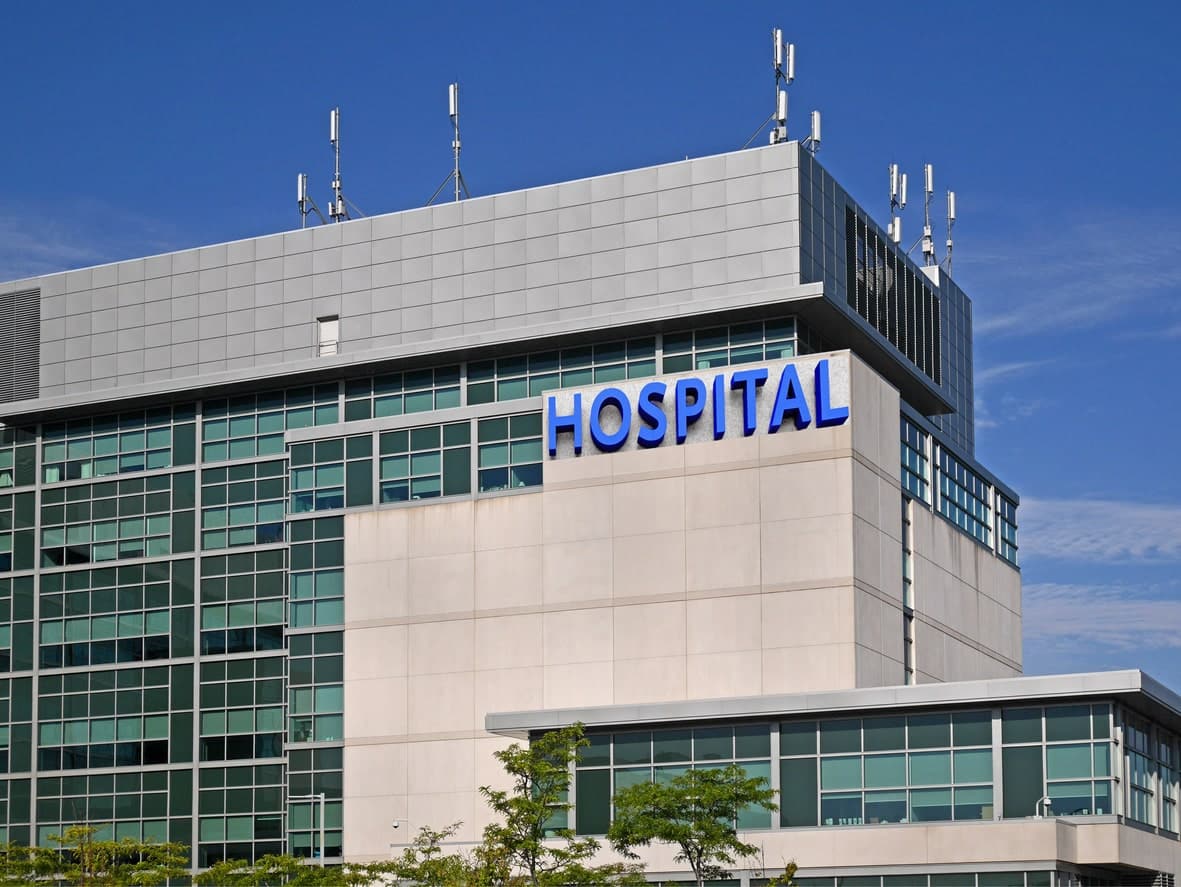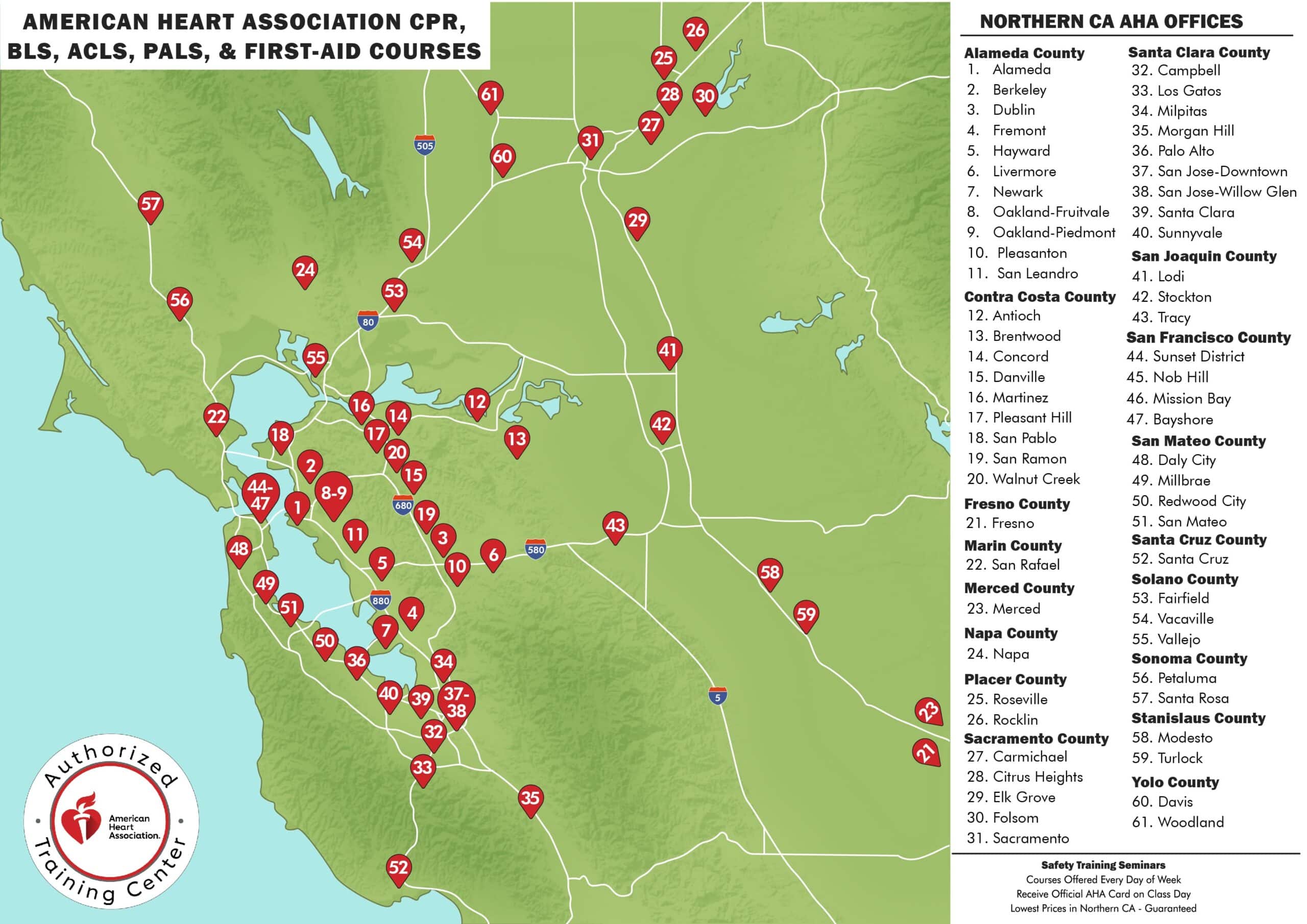
CPR Classes in Concord
BLS, ACLS, PALS, CPR & First-aid Classes
What is American Heart Association RQI
The American Heart Association RQI (Resuscitation Quality Improvement) program is one of the most popular, modern, and efficient ways for medical and healthcare professionals to receive their official American Heart Association BLS, ACLS, and PALS certification cards.
Three Easy Steps
1. Take the American Heart Association online course at home (a few hours).
2. Arrive to one of our 45 local offices and practice with the VAM (voice assisted manikin).
3. Receive your certification card on the day of the class.

About American Heart Association RQI
Entry Instructions for Concord CPR Classroom
Concord, California: A Dynamic Blend of History, Progress, and Community Spirit
Nestled at the confluence of the San Francisco Bay Area and the East Bay, Concord, California, stands as a vibrant city that beautifully weaves together its rich historical legacy with a forward-thinking spirit and a strong sense of community. From its diverse cultural scene to its natural beauty and thriving economy, Concord offers a multifaceted experience that captures the essence of modern suburban living.
Historical Roots and Cultural Significance: Concord’s history dates back to the 19th century, when it served as a vital stop along the route of the Transcontinental Railroad. The city’s historical significance is preserved in sites like the Concord Historical Society Museum, which showcases artifacts, photographs, and stories that illuminate its past. The city’s contribution to the World War II effort is commemorated at the Port Chicago Naval Magazine National Memorial, reminding visitors of the sacrifices made by those who served.
Cultural Diversity and Expression: Concord’s cultural mosaic is a testament to its diverse population and its dedication to celebrating different backgrounds and perspectives. The city hosts a variety of cultural events, such as the Todos Santos Plaza’s music and arts festivals, where residents and visitors can experience the rich tapestry of traditions that define Concord’s identity. The Lesher Center for the Arts serves as a hub for performing arts, showcasing theater productions, musical performances, and artistic exhibitions that contribute to the city’s vibrant cultural scene.
Thriving Economy and Innovation: Concord’s strategic location within the Bay Area has made it a hub of economic activity and innovation. The city’s business landscape is a testament to its adaptability and growth, with a diverse range of industries contributing to its economic vitality. As the regional center for transportation and commerce, Concord is home to a mix of businesses, from local startups to established corporations, further solidifying its position as a dynamic economic force.
Natural Beauty and Outdoor Recreation: Amidst its urban development, Concord has not lost touch with its natural surroundings. The city is surrounded by stunning landscapes that offer opportunities for outdoor enthusiasts to connect with nature. Mount Diablo State Park, with its panoramic vistas, hiking trails, and unique rock formations, is a haven for those seeking outdoor adventure and breathtaking views of the Bay Area. The Iron Horse Regional Trail provides a scenic pathway for walking, jogging, and cycling, allowing residents to explore the city’s beauty at a leisurely pace.
Community Engagement and Unity: Concord’s strong sense of community is evident in its many local initiatives and events that bring people together. The Concord Farmers Market, held year-round, provides a platform for local growers and artisans to share their products while fostering a sense of camaraderie among attendees. The Concord Pavilion, a renowned outdoor music venue, hosts concerts and events that draw residents and visitors alike, contributing to the city’s vibrant social fabric.
Education and Lifelong Learning: Concord’s commitment to education is reflected in its schools, libraries, and cultural institutions. The city’s educational facilities provide a nurturing environment for students to excel academically and personally. Libraries like the Concord Library offer resources and programs that promote lifelong learning and intellectual growth. Additionally, the city’s support for arts and culture serves as a foundation for fostering creativity and critical thinking among its residents.
Preserving Heritage and Embracing Change: While Concord embraces progress and innovation, it also places a strong emphasis on preserving its historical heritage. The city’s balance between growth and preservation is evident in its architecture, landmarks, and community efforts to honor its past. This harmonious blend of old and new contributes to Concord’s unique character and enduring appeal.
In conclusion, Concord, California, encapsulates the essence of a thriving and interconnected community that values history, progress, and diversity. Its rich cultural tapestry, natural beauty, economic vitality, and strong sense of community make it a dynamic destination that offers something for everyone. Whether exploring its historical sites, immersing oneself in its cultural events, or simply enjoying its scenic landscapes, Concord invites residents and visitors alike to experience the magic of a city that harmoniously marries the past, present, and future.
Life-Saving Skills: Exploring CPR, BLS, ACLS, and PALS Classes
In the realm of emergency medical care, few skills are as crucial as Cardio-Pulmonary Resuscitation (CPR) and Advanced Cardiac Life Support (ACLS), Basic Life Support (BLS), and Pediatric Advanced Life Support (PALS) techniques. These life-saving techniques form the backbone of first response and medical intervention, often making the difference between life and death in critical situations. Let’s delve into the significance of each of these classes and their role in maintaining public health and safety.
Cardio-Pulmonary Resuscitation (CPR): CPR is a fundamental life-saving technique that can be administered by trained individuals to sustain blood circulation and provide artificial respiration when a person’s heart has stopped beating. CPR involves a combination of chest compressions and rescue breaths, aimed at keeping oxygenated blood flowing to vital organs until professional medical help arrives. CPR classes provide participants with the skills to recognize cardiac arrest, perform effective chest compressions, and deliver rescue breaths. These classes are vital for both medical professionals and laypersons, empowering them to respond swiftly and effectively in emergencies.
Basic Life Support (BLS): BLS takes CPR skills to the next level by incorporating additional techniques and equipment usage. BLS classes are designed for healthcare providers, including doctors, nurses, paramedics, and emergency medical technicians (EMTs). Participants learn how to assess a patient’s condition, deliver high-quality CPR, and use automated external defibrillators (AEDs) to restore a regular heartbeat. BLS training emphasizes teamwork, effective communication, and quick decision-making to optimize patient outcomes during cardiac emergencies.
Advanced Cardiac Life Support (ACLS): ACLS is an advanced course tailored for healthcare professionals who are involved in the management of cardiac arrest and other cardiovascular emergencies. ACLS builds upon the foundation of BLS and focuses on identifying and treating potentially life-threatening conditions such as stroke, myocardial infarction, and arrhythmias. Participants learn to interpret electrocardiograms (ECGs), administer medications, and perform advanced airway management. ACLS classes equip medical personnel with the skills to respond confidently to complex cardiac scenarios, ensuring comprehensive care for critically ill patients.
Pediatric Advanced Life Support (PALS): PALS training is geared towards healthcare providers who care for infants and children during emergencies. Pediatric patients have unique physiological needs, making PALS classes essential for those working in pediatrics, emergency medicine, and intensive care. PALS courses cover topics such as pediatric assessment, effective respiratory support, and the management of pediatric cardiac arrest. Participants gain the knowledge and skills necessary to provide specialized care and interventions that can make a critical difference in the outcomes of pediatric emergencies.
NRP, or Neonatal Resuscitation Program, is a critical medical initiative that focuses on saving newborns who struggle to breathe at birth. This specialized training equips healthcare providers with the skills to assess and manage respiratory distress in infants. NRP emphasizes a systematic approach, teaching effective ventilation techniques and chest compressions if needed. Regularly updated guidelines ensure that participants stay current with the best practices in neonatal care. By enhancing healthcare professionals’ abilities to respond swiftly and effectively to newborn respiratory challenges, NRP plays a vital role in improving infant survival rates and ensuring a healthier start to life.
First-aid classes offer indispensable life skills that empower individuals to respond confidently in emergencies. These structured courses cover a spectrum of situations, from minor injuries to critical incidents, teaching participants how to provide immediate care before professional help arrives. Participants learn to administer CPR, treat wounds, manage choking, and address common health crises. Hands-on training fosters essential skills and boosts confidence, enabling swift and effective action in times of need. First-aid classes are invaluable for workplaces, homes, and communities, creating a network of capable first responders. Mastering these skills not only saves lives but also fosters a safer and more prepared society.
Incorporating these life-saving techniques into healthcare systems, workplaces, and communities can significantly enhance the response to medical emergencies. Quick and effective interventions provided by individuals trained in CPR, BLS, ACLS, and PALS can stabilize patients and improve their chances of survival before professional medical assistance arrives. Moreover, these classes promote a culture of preparedness, empowering individuals to step forward and take action when faced with emergency situations.
In conclusion, American Heart Association CPR, BLS, ACLS, and PALS classes play an indispensable role in equipping individuals with the skills and knowledge needed to respond effectively to various medical emergencies. These courses bridge the gap between bystander assistance and professional medical care, ultimately contributing to improved patient outcomes and increased survival rates. By investing in these life-saving classes, individuals and healthcare professionals alike become vital links in the chain of survival, ensuring that timely and appropriate care is delivered when it matters most.
Our Blog

Hospitals & Medical Centers in Concord
Stay informed, stay prepared, and take proactive steps towards maintaining your health with the exceptional medical institutions in Concord, CA.

Psychological Recovery for CPR Survivors: A Journey Beyond Survival
Explore the challenges and coping mechanisms associated with psychological recovery for CPR survivors. Understand the importance of mental health support in their journey beyond survival.

Why CPR is Important in Healthcare
Cardio-pulmonary resuscitation (CPR) is a life-saving technique that everyone should know how to perform. It involves a series of actions designed to help someone who


